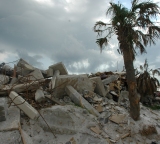MIAMI (CBS4) — As South Florida tracks Hurricane Irene and on the 19th Anniversary of Hurricane Andrew, a new tool has been launched for Miami-Dade residents regarding the threat of storm surge.
Storm surge is the greatest threat to life and property from a hurricane. It occurs when water from the ocean is pushed toward the shore by the force of the winds swirling around a hurricane.
County residents can now use the Storm Surge Simulator which combines historical data and modern day technology to see what storm surge can mean to them and their property.
Storm surge is the primary reason why Miami-Dade residents are asked to evacuate prior to a hurricane event.
With the new Storm Surge Simulator, residents type in their address, pick the intensity of the hurricane (Category 1-5), select the image of a person or home, and let the simulator do the rest. For those living in Evacuation Zones, the simulator is a reminder of the potential impact of storm surge.
More than a half a million people live in one of Miami-Dade County’s three Hurricane Evacuation Zones.
“Miami-Dade residents are encouraged to use the Storm Surge Simulator to educate themselves on their vulnerability to storm surge and put an appropriate hurricane evacuation plan into place,” said Curtis Sommerhoff, Director of the Miami-Dade Department of Emergency Management. “Understanding your risk can help mitigate the impacts of a disaster. The launch of the simulator is especially timely as we are in the middle of a very active hurricane season.”
To try out the simulator, go to www.miamidade.gov.
The Storm Surge Simulator is made possible through a partnership between Miami-Dade County’s Department of Emergency Management and Florida International University’s International Hurricane Research Center and School of Computing and Information Sciences.

